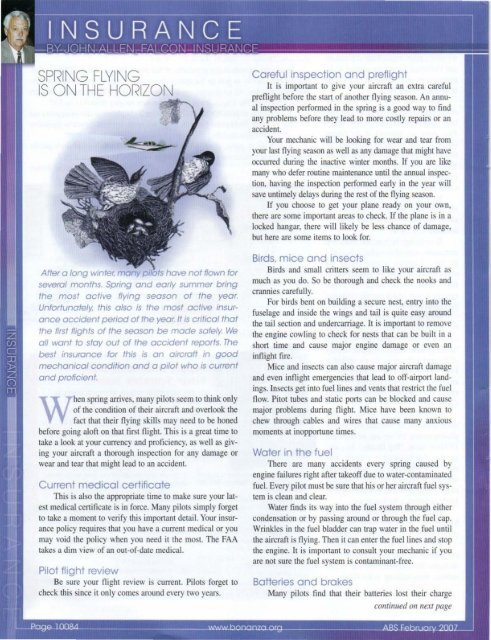February 2007 - American Bonanza Society
February 2007 - American Bonanza Society
February 2007 - American Bonanza Society
Create successful ePaper yourself
Turn your PDF publications into a flip-book with our unique Google optimized e-Paper software.
SPRING FLYINGIS ON THE HORIZONAfter a long winter. many have not flown forseveral months. Spring and early summer bringthe most active flying season of the year.Unfortunately, this also is the most active insuranceoccident period of the year. It is critical thatthe first flights of the season be made safely Weall want to stay out of the accident reports. Thebest insurance for this is an aircraft in goodmechanical condition and a pilot who is currentand proficient.When spring arrives, many pilots seem to think onlyof the condition of their aircraft and overlook thefact that their flying skills may need to be honedbefore going aloft on that first flight. This is a great time totake a look at your currency and proficiency, as well as givingyour aircraft a thorough inspection for any damage orwear and tear that might lead to an accident.Current medical certificateThis is also the appropriate time to make sure your latestmedical certificate is in force. Many pilots simply forgetto take a moment to verify this important detail. Your insurancepolicy requires that you have a current medical or youmay void the policy when you need it the most. The FAAtakes a dim view of an out-of-date medical.Pilot flight reviewBe sure your flight review is current. Pilots forget tocheck this since it only comes around every two years.Careful inspection and preflightIt is important to give your aircraft an extra carefulpreflight before the start of another flying season. An annualinspection performed in the spring is a good way to findany problems before they lead to more costly repairs or anaccident.Your mechanic will be looking for wear and tear fromyour last flying season as well as any damage that might haveoccurred during the inactive winter months. If you are likemany who defer routine maintenance until the annual inspection,having the inspection performed early in the year willsave untimely delays during the rest of the fl ying season.If you choose to get your plane ready on your own,there are some important areas to check. If the plane is in alocked hangar, there wi ll likely be less chance of damage,but here are some items to look for.Birds. mice and insectsBirds and small critters seem to like your aircraft asmuch as you do. So be thorough and check the nooks andcrannies carefully.For birds bent on building a secure nest, entry into thefu selage and inside the wings and tail is quite easy aroundthe tail section and undercarriage. It is important to removethe engine cowling to check for nests that can be built in ashort time and cause major engine damage or even anin flight fire.Mice and insects can also cause major aircraft damageand even inflight emergencies that lead to off-airport landings.Insects get into fuel lines and vents that restrict the fuelflow. Pitot tubes and static ports can be blocked and causemajor problems during flight. Mice have been known tochew through cables and wires that cause many anxiousmoments at inopportune times.Water in the fuelThere are many accidents every spring caused byengine failures right after takeoff due to water-contaminatedfuel. Every pilot must be sure that his or her aircraft fuel systemis clean and clear.Water finds its way into the fuel system through eitherco ndensation or by passing around or through the fuel cap.Wrinkles in the fuel bladder can trap water in the fu el untilthe aircraft is flying. Then it can enter the fuel Jines and stopthe engi ne. It is important to consult your mechanic if youare not sure the fuel system is contami nant-free.Batteries and brakesMany pilots find that their batteries lost their chargecOlllilllled all lIext page

















